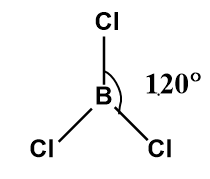
The nature of hybridization in the \[BC{l_3}\]molecule is
(a) \[sp\]
(b) \[s{p^2}\]
(c) \[s{p^3}\]
(d) \[s{p^3}d\]
Answer
221.7k+ views
Hint: With the help of the concept of hybridization, we can easily predict the structure of any given molecule along with the bond angle. The \[s{p^3}\], \[s{p^2}\]and \[sp\]hybridization represents the tetrahedral, planar, and linear geometries respectively.
Complete step by step solution:The \[BC{l_3}\]molecule is known as boron trichloride.
In the \[BC{l_3}\]molecule, the boron atom occupies a central position and is connected with three chlorine atoms.
The boron atom in the ground state possesses \[1{s^2},2{s^2},2{p^1}\]electronic configuration. During the formation of \[BC{l_3}\]molecule, the one electron from \[2{s^2}\]is excited to the \[2p\]orbital to form \[1{s^2},2{s^1},2{p_x}^1,2{p_y}^1\]excited state electronic configuration. These three unpaired electrons are paired with the unpaired electron of chlorine and form three \[B - Cl\]bonds.

Image: Structure of boron trichloride (\[BC{l_3}\]).
Now, to determine the hybridization of \[BC{l_3}\]molecules two methods can be used.
(1) By using the following formula, we can predict the hybridization of any given molecule.
\[Hybridization(H) = \frac{{V + M - C + A}}{2}\] (Eq.1)
Whereas V=number of valence electrons on the central atom
M= a number of monovalent atoms
C= charge on the cation
A=charge on anion
Hence, \[Hybridization(H) = \frac{{3 + 3 - 0 + 0}}{2} = \frac{6}{2} = 3\]
The value of 3 will be equal to \[s{p^2}\] hybridization. Therefore, we can easily say that \[BC{l_3}\]has \[s{p^2}\]hybridization and trigonal planar structure with a bond angle \[120^\circ \].
(2) By counting the total number of sigma bonds:
By counting the total number of the sigma bond, we can exactly predict the type of hybridization:
If the sum of the sigma bond is two, then the hybridization will be \[s{p^{}}\].
If the sum of the sigma bond is three, then the hybridization will be \[s{p^2}\].
If the sum of the sigma bond is four, then the hybridization will be \[s{p^3}\].
If the sum of the sigma bond is five, then the hybridization will be \[s{p^3}d\].
If the sum of the sigma bond is six, then the hybridization will be \[s{p^3}{d^2}\].
Therefore, the \[BC{l_3}\]molecule has three sigma bonds. Hence the hybridization will be \[s{p^2}\].
Therefore from the above explanation we can say option (b) will be the correct option:
Note: In \[BC{l_3}\]molecule, the boron atom has \[ + 3\] oxidation state.
The \[BC{l_3}\]molecule is an electron-deficient species i.e., it can accept the electron pair from an electron donor moiety.
Borazine (\[{N_3}{B_3}{H_6}\]) is the compound of boron, which is called inorganic benzene.
Complete step by step solution:The \[BC{l_3}\]molecule is known as boron trichloride.
In the \[BC{l_3}\]molecule, the boron atom occupies a central position and is connected with three chlorine atoms.
The boron atom in the ground state possesses \[1{s^2},2{s^2},2{p^1}\]electronic configuration. During the formation of \[BC{l_3}\]molecule, the one electron from \[2{s^2}\]is excited to the \[2p\]orbital to form \[1{s^2},2{s^1},2{p_x}^1,2{p_y}^1\]excited state electronic configuration. These three unpaired electrons are paired with the unpaired electron of chlorine and form three \[B - Cl\]bonds.

Image: Structure of boron trichloride (\[BC{l_3}\]).
Now, to determine the hybridization of \[BC{l_3}\]molecules two methods can be used.
(1) By using the following formula, we can predict the hybridization of any given molecule.
\[Hybridization(H) = \frac{{V + M - C + A}}{2}\] (Eq.1)
Whereas V=number of valence electrons on the central atom
M= a number of monovalent atoms
C= charge on the cation
A=charge on anion
Hence, \[Hybridization(H) = \frac{{3 + 3 - 0 + 0}}{2} = \frac{6}{2} = 3\]
The value of 3 will be equal to \[s{p^2}\] hybridization. Therefore, we can easily say that \[BC{l_3}\]has \[s{p^2}\]hybridization and trigonal planar structure with a bond angle \[120^\circ \].
(2) By counting the total number of sigma bonds:
By counting the total number of the sigma bond, we can exactly predict the type of hybridization:
If the sum of the sigma bond is two, then the hybridization will be \[s{p^{}}\].
If the sum of the sigma bond is three, then the hybridization will be \[s{p^2}\].
If the sum of the sigma bond is four, then the hybridization will be \[s{p^3}\].
If the sum of the sigma bond is five, then the hybridization will be \[s{p^3}d\].
If the sum of the sigma bond is six, then the hybridization will be \[s{p^3}{d^2}\].
Therefore, the \[BC{l_3}\]molecule has three sigma bonds. Hence the hybridization will be \[s{p^2}\].
Therefore from the above explanation we can say option (b) will be the correct option:
Note: In \[BC{l_3}\]molecule, the boron atom has \[ + 3\] oxidation state.
The \[BC{l_3}\]molecule is an electron-deficient species i.e., it can accept the electron pair from an electron donor moiety.
Borazine (\[{N_3}{B_3}{H_6}\]) is the compound of boron, which is called inorganic benzene.
Recently Updated Pages
JEE Main 2022 (July 26th Shift 1) Physics Question Paper with Answer Key

JEE Main 2022 (June 26th Shift 2) Chemistry Question Paper with Answer Key

Apparent Frequency Explained: Formula, Uses & Examples

JEE Main 2023 (January 30th Shift 2) Chemistry Question Paper with Answer Key

Displacement Current and Maxwell’s Equations Explained

JEE Main 2022 (June 29th Shift 1) Maths Question Paper with Answer Key

Trending doubts
Understanding Atomic Structure for Beginners

Understanding Average and RMS Value in Electrical Circuits

What Are Elastic Collisions in One Dimension?

Free Radical Substitution and Its Stepwise Mechanism

Understanding Geostationary and Geosynchronous Satellites

Understanding How a Current Loop Acts as a Magnetic Dipole

Other Pages
NCERT Solutions For Class 11 Chemistry Chapter 8 Redox Reactions in Hindi - 2025-26

JEE Advanced 2026 Notes

Understanding Entropy Changes in Different Processes

Common Ion Effect: Concept, Applications, and Problem-Solving

Devuthani Ekadashi 2025: Correct Date, Shubh Muhurat, Parana Time & Puja Vidhi

Difference Between Exothermic and Endothermic Reactions: Key Differences, Examples & Diagrams




